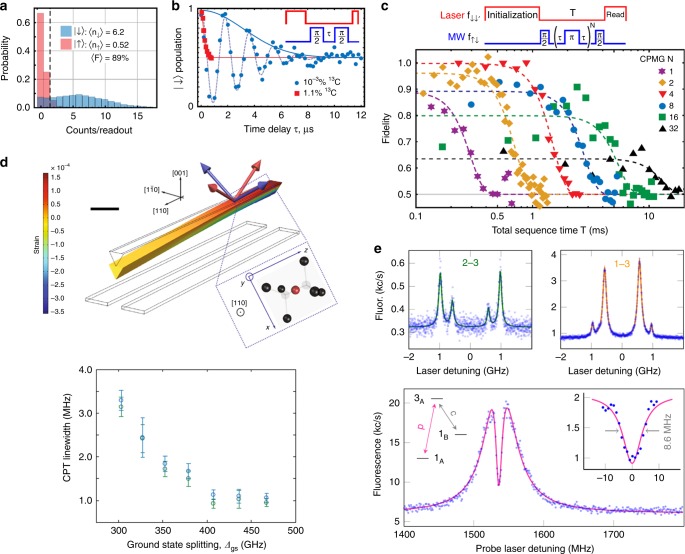Fig. 2.
Coherent spin control in the SiV– centre. a Spin control of the silicon-vacancy centre at millikelvin temperatures. Single-shot spin readout with magnetic field B = 2.7 kG: a 20-ms-long laser pulse pumping the transition A1 (see Fig. 1c) is used to read out the state after a 250-ms-long initialization pump of the A1 (red) or B2 transition (blue). b Ramsey interference measurement of T2⋆ for two samples: 13C purified sample (blue, 0.001% 13C) and unprocessed natural sample (red, 1.1% 13C). The microwave field is detuned by ~550 kHz from the Zeeman splitting between |1〉 and |2〉. The duration of the initialization and readout period are 15 and 2 ms for the 0.001% 13C sample, and 2 and 1.5 ms for the 1.1% 13C sample. c Carr–Purcell–Meiboom–Gill (CPMG) pulse sequence with N = 1, 2, 4, 8, 16 and 32 pulses in a sample with low 13C concentrations and with an aligned magnetic field B ≈ 1.6 kG at 100 mK. Durations of the initialization and readout laser pulses are 100 and 15 ms, respectively. Dashed lines are fits to exp[–(T/T2)4]. d Suppression of spin dephasing via strain engineering. The simulated bending of a diamond cantilever containing a SiV– centre is at an applied voltage of 200 V between top and bottom electrodes. The component of the strain tensor in the direction of the long axis of the cantilever is indicated by the colour scale. Scale bar corresponds to 2 μm. The linewidth of coherent population trapping (CPT) dips as a function of ground-state orbital splitting ΔGS is shown, indicating an increase in spin coherence for higher levels of strain. e Demonstration of coherent manipulation trapping with GeV– centres. The top panels represent coherent excitation from the lower (1) and higher (2) energy ground state manifold to the excited state (3). A dip with full-width at half-maximum of (8.6 ± 0.5) MHz is visible, which corresponds to a coherence lifetime of (19 ± 1) ns. Panels a, b and c are reprinted with permission from ref. 36. Copyright 2017 by the American Physical Society; panel d is reprinted from ref. 76, Copyright 2018 by Springer Nature; panel e is reprinted with permission from ref. 37 Copyright 2017 by the American Physical Society.

